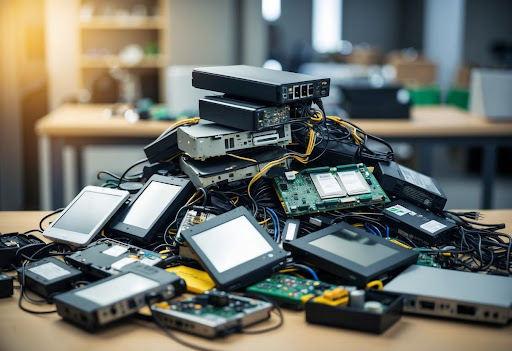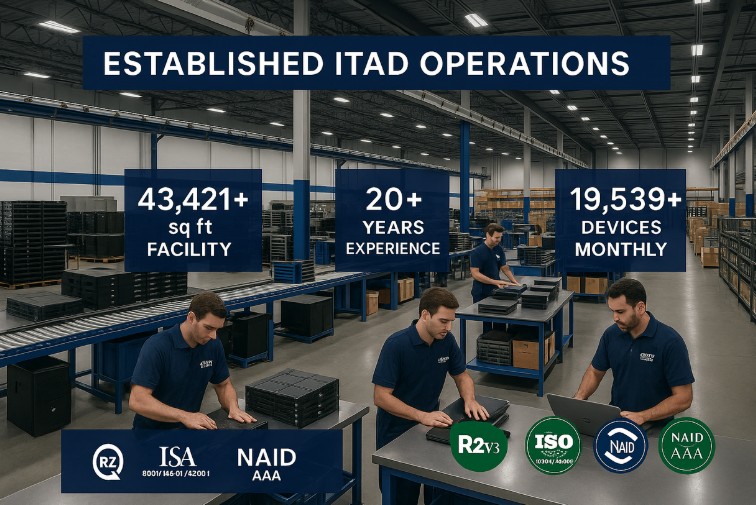When it comes to disposing of old technology, many organizations face a choice between IT Asset Disposition (ITAD) and recycling. While these terms are often used interchangeably, they serve different purposes in the technology lifecycle.
ITAD focuses on secure data destruction, value recovery, and responsible disposal. Meanwhile, e-waste recycling primarily concerns safely breaking down electronic components after they’ve reached the end of their useful life.
The distinction matters for both your bottom line and environmental impact. ITAD companies specialize in maximizing the remaining value of your technology assets through refurbishment and remarketing, often providing you with a return on your initial investment. In contrast, electronics recycling focuses on properly disposing of materials that can no longer be used, ensuring harmful substances don’t end up in landfills.
Understanding these differences helps you make better decisions about your outdated equipment. When your devices still have market value or contain sensitive data, ITAD services offer comprehensive solutions beyond simple disposal. When equipment has truly reached the end of its lifecycle, proper recycling becomes the environmentally responsible choice for your organization.
Understanding IT Asset Disposition (ITAD)
IT Asset Disposition (ITAD) is a structured approach to managing end-of-life technology assets that focuses on data security, compliance, and environmental responsibility. Far beyond simple disposal, ITAD offers a strategic process to decommission IT equipment in a way that protects your organization and the planet.
The Core Objectives of ITAD
The primary goal of ITAD is to maximize the value of your outdated IT assets while ensuring complete data security. When you work with an ITAD provider, they focus on data security, asset recovery, and compliance as top priorities.
ITAD helps you mitigate security risks by properly destroying sensitive data on all devices. This protection extends beyond basic deletion to include certified data destruction methods that prevent unauthorized data recovery.
Another key objective is regulatory compliance. ITAD ensures your organization meets legal requirements for proper disposal of electronic equipment, helping you avoid potential fines and reputation damage.
ITAD also aims to recover value from your assets through remarketing when possible, turning potential waste into financial return.
Key ITAD Services
Data destruction is perhaps the most critical ITAD service. Your ITAD provider will use methods like data wiping, degaussing, or physical destruction to permanently remove sensitive information from devices.
Remarketing services help you maximize the value of outdated IT assets through resale channels. This extends equipment lifespan and provides financial returns on your initial investments.
Refurbishment involves repairing and updating equipment for reuse. This process can include hardware upgrades, software installation, and cosmetic improvements.
Redeployment services help you reallocate usable equipment within your organization, reducing new purchase costs. Your ITAD provider will clean, test, and prepare devices for their new users.
Asset tracking and reporting is offered by many ITAD providers to document the complete chain of custody for your equipment and provide detailed compliance documentation.
Defining Recycling in the Context of IT
IT recycling refers to the process of breaking down and reusing materials from electronic devices that have reached the end of their useful life. This practice focuses primarily on physical hardware components rather than data security or asset value recovery.
E-Waste Recycling Fundamentals
Electronics recycling, often called e-waste recycling, is a sequential process of dismantling computer hardware and devices to separate their components. When you recycle IT equipment, the goal is to recover valuable materials like copper, aluminum, gold, and rare earth metals while properly handling hazardous substances.
Unlike ITAD, recycling typically doesn’t prioritize data security or recovering financial value from working equipment. The primary focus is environmental responsibility and resource conservation.
Computer recycling follows specific protocols to ensure harmful materials don’t enter landfills. You’ll find that proper e-waste recycling includes:
- Physical destruction of components
- Separation of materials by type
- Processing raw materials for reuse
- Safe disposal of hazardous substances
Electronics recycling generally happens when equipment has no remaining functional value and can’t be refurbished or remarketed.
The Lifecycle of IT Assets
Every IT asset follows a predictable journey from acquisition through retirement. Understanding this lifecycle helps organizations make informed decisions about when to decommission equipment and how to handle assets that still have value.
Decommissioning Equipment
When your IT assets reach the end of their useful life, proper decommissioning becomes essential. This process involves several key steps to ensure security and compliance:
- Identification: Determine which assets—servers, laptops, desktops, smartphones, or tablets—are ready for retirement based on performance, age, or business needs. This should be documented in your asset management system.
- Data Sanitization: All storage devices must undergo secure data destruction to prevent data breaches. This might involve:
- Secure wiping using DOD-standard software
- Physical destruction of hard drives
- Certificate of destruction documentation
- Inventory Reconciliation: Remove the equipment from your network and update your asset tracking system accordingly.
- Environmental Compliance: Ensure toxic materials in servers and other equipment are handled according to regulations.
Redeployment of IT Hardware
Not all decommissioned IT assets need to exit your organization. Redeployment offers a cost-effective alternative that extends equipment lifespan.
When you assess retired assets through the ITAD process, many items may still have significant value. Laptops from one department might perfectly suit the needs of another team with less demanding requirements.
Before redeployment, your IT team should:
- Thoroughly test functionality
- Update operating systems and software
- Replace worn components such as batteries or keyboards
- Sanitize data from previous users
Redeployment works particularly well for smartphones and tablets, which often remain capable even after newer models arrive. Reallocating these devices to field staff or for specialized applications maximizes your investment.
Creating a formal redeployment policy helps standardize the process. This should include minimum specifications for different use cases and a clear workflow for requesting repurposed equipment.
Environmental Impact and Sustainability
Both ITAD and recycling contribute to environmental protection, but they do so in different ways.
Preventing Pollution with ITAD
ITAD services are environmentally friendly because they prevent e-waste accumulation in landfills. When you choose ITAD, you’re prioritizing reuse over recycling, which requires less energy and fewer resources.
Many ITAD providers follow a zero-landfill policy, ensuring that no electronic components end up in dumps where they can leach harmful chemicals into soil and water.
ITAD extends device lifecycles through refurbishment and remarketing. This means you’re helping to:
- Reduce the need for raw material extraction
- Lower manufacturing emissions
- Decrease energy consumption
If equipment can’t be reused, ITAD services break it down into reusable raw materials that go back into manufacturing. This closed-loop approach is more sustainable than traditional disposal methods.
By leveraging ITAD, your organization actively supports sustainability goals while maintaining data security and compliance requirements.
Compliance, Legalities, and Data Security
When disposing of IT assets, businesses must navigate a complex landscape of regulations while ensuring sensitive data remains protected. Legal requirements and security protocols differ significantly between ITAD and standard recycling approaches.
Adhering to Computer Disposal Laws
Businesses face strict data disposal laws that govern how you handle outdated equipment. ITAD services help you maintain compliance with regulations like GDPR, HIPAA, and GLBA, which mandate proper data handling procedures.
Government agencies regularly audit disposal practices—particularly for organizations handling sensitive information. Penalties for non-compliance can be severe, including substantial fines and potential legal action.
When disposing of data center equipment, you need verifiable documentation of proper handling. ITAD providers offer certificates of destruction that serve as critical proof during regulatory audits.
Ensuring Secure Data Destruction
Standard recycling rarely addresses the critical issue of data security.
ITAD providers implement multiple data destruction methods, including:
- Degaussing
- Physical destruction
- Certified data wiping
You should confirm that your ITAD partner follows NIST 800-88 guidelines for media sanitization. These standards ensure complete data removal, preventing potential breaches even if equipment is reused.
Many industries require specific destruction protocols. Healthcare organizations must ensure HIPAA compliance, while financial institutions follow different requirements for secure data elimination.
A reliable ITAD service provider will issue detailed reports documenting exactly how your data was destroyed. This focus on data security represents a fundamental difference from basic electronics recycling, which primarily concentrates on material recovery rather than information protection.
The Financial Aspects of ITAD and Recycling
Both ITAD and recycling offer financial benefits, but they work in different ways. ITAD focuses on recovering value from still-functioning equipment, while recycling extracts value from materials in non-working devices.
Maximizing Market Value Through Remarketing
Remarketing is one of the most financially beneficial aspects of ITAD. When you choose ITAD over simple recycling, you can recover significant value from your used IT assets.
Rather than just extracting material value, remarketing allows you to sell functioning equipment to new users. Your outdated equipment may still have 15-30% of its original value. Many organizations dispose of IT assets while they’re still working simply because they’ve upgraded to newer models.
When you sell used computer hardware through ITAD services, you can:
- Generate immediate revenue from equipment you no longer need
- Offset the cost of new technology purchases
- Reduce disposal costs associated with recycling
- Extend the useful life of valuable equipment
The key is working with ITAD providers who understand market demand and can properly sanitize data before remarketing your assets.
Difference in Process: ITAD vs. Recycling
ITAD and recycling follow distinct operational pathways that impact data security, asset value, and environmental outcomes. The handling procedures differ significantly in documentation, tracking methods, and ultimate destinations of the materials.
Chain of Custody in ITAD
One of the key differences in ITAD is the maintenance of a rigorous chain of custody throughout the entire process. Each item receives a unique identifier and tracking number, creating an unbroken documentation trail from collection to final disposition.
The ITAD process typically follows these steps:
- Asset Collection: Secure pickup with inventory verification
- Transportation: GPS-tracked secure vehicles
- Processing: Detailed intake recording
- Data Destruction: Certified wiping or physical destruction
- Value Assessment: Determination of resale potential
You’ll receive comprehensive reporting at each stage—including certificates of data destruction that verify compliance with regulations like HIPAA or GDPR—protects your organization from potential liability.
Recycling Pathways for Electronics
In contrast, electronics recycling follows a more materials-focused approach. When you send items for recycling, they typically enter a process aimed at resource recovery rather than data security or value preservation.
The standard recycling pathway includes:
- Initial sorting by device type and condition
- Manual disassembly of components
- Mechanical shredding or crushing
- Material separation into metals, plastics, and glass
- Refining and processing raw materials
Unlike ITAD’s emphasis on data security and value recovery, recycling prioritizes environmental sustainability and resource conservation. Basic recycling may not provide the detailed tracking documentation that ITAD offers.
Your materials might move through multiple facilities during recycling, making comprehensive tracking more challenging. While responsible recyclers follow environmental standards, the focus remains on material recovery rather than maintaining the chain of custody for each specific device.
Selecting ITAD and Recycling Partners
Choosing the right partner for your IT asset disposition or recycling needs requires careful evaluation. The right provider will align with your organization’s sustainability goals while ensuring data security and regulatory compliance.
Certifications and Standards for ITAD Providers
When selecting an ITAD partner, certifications are your best indicator of quality and compliance. Look for the following credentials:
- R2 (Responsible Recycling) ensures environmentally responsible practices
- ISO certifications such as:
- ISO 9001
- ISO 14001
- ISO 45001
- NAID AAA certification verifies that the ITAD provider follows strict protocols for data destruction and sanitization
Legitimate ITAD partners will readily provide proof of their credentials and explain how they maintain compliance with industry standards. Always request documentation of these certifications during your selection process.
Check if your potential partner offers a Certificate of Destruction or Certificate of Recycling for each processed asset. These documents provide valuable audit trails and demonstrate your company’s commitment to proper disposal practices.
Real-World Application of ITAD and Recycling
Companies face important choices when disposing of old IT equipment. The right approach depends on the value of the devices, data security needs, and environmental goals.
Case Studies and Examples
- Corporate Solutions: When Microsoft upgraded 30,000 devices across their offices, they chose an ITAD provider who refurbished 85% of the equipment. This generated substantial revenue while keeping devices out of landfills.
- Data Security Success: A healthcare company recently faced a major challenge with their storage data destruction requirements. They worked with an ITAD specialist who provided on-site data wiping and detailed chain-of-custody documentation for 500+ servers, preventing potential data breaches.
- IT Infrastructure Removal: When a bank closed multiple branches, their facilities needed complete IT infrastructure removal. The bank used a hybrid approach: – high-value networking equipment went through ITAD for resale, while damaged components were sent for recycling. This maximized value recovery while ensuring environmental compliance.
You can evaluate your needs by considering device age, condition, data sensitivity, and potential resale value. As a general rule, equipment under 3-4 years old, ITAD typically offers better returns.
Frequently Asked Questions
IT Asset Disposition (ITAD) and recycling differ in key areas including data security, environmental impact, handling specialized components, and regulatory compliance. These differences impact how organizations should approach end-of-life IT asset management. Below are answers to the most common questions about how these methods compare and when to use each.
How do IT Asset Disposition (ITAD) services manage data security during device recycling?
ITAD providers implement strict data security protocols that exceed standard recycling practices.
- They use certified data sanitization methods like DoD-compliant wiping or physical destruction of storage media to ensure complete data removal.
- Each device is tracked from collection to final disposition with detailed chain-of-custody documentation and destruction certificates provided for compliance records.
- ITAD services often maintain secure facilities with restricted access and surveillance to prevent unauthorized handling of data-bearing devices.
What distinguishes ITAD processes from traditional recycling in terms of environmental impact?
ITAD prioritizes reuse before recycling, which conserves more resources and energy.
Your equipment undergoes detailed assessment to identify components that can be refurbished, remarketed, or repurposed rather than immediately broken down.
This extends the lifecycle of IT assets and reduces the environmental footprint compared to manufacturing new products. Only after exhausting all reuse options does ITAD send materials for recycling.
ITAD providers typically maintain higher environmental certifications and more stringent downstream vendor management. This ensures your equipment never ends up in landfills or exported to countries with poor environmental practices.
Can all IT equipment components be recycled, or are there items that require specialized ITAD services?
Not all IT components can be handled through standard recycling channels.
- Data-bearing devices—like servers, laptops, and storage drives—require specialized ITAD processing to address security concerns.
- High-value assets—like newer model computers, networking equipment, and enterprise-grade hardware—with resale value benefits from ITAD’s remarketing capabilities, generating potential returns for your organization.
- Specialized components like backup tapes, custom configurations, and equipment containing hazardous materials need ITAD expertise for proper handling. Standard recycling programs often lack the capabilities to safely process these more complex items.
What are the critical steps taken in ITAD that are not typically found in standard recycling?
ITAD includes comprehensive asset tracking and reporting that documents the entire disposition process. Key ITAD steps that distinguish it from standard recycling are:
- Detailed inventory lists
- Data destruction certificates
- Environmental impact reports.
- Certified data sanitization protocols
- This critical security step is often absent in standard recycling programs that focus primarily on material recovery rather than data protection.
In what ways does ITAD ensure regulatory compliance when handling electronic waste?
ITAD providers maintain industry certifications like R2 standards that verify adherence to strict environmental and security protocols. These certifications protect you from liability risks.
You receive comprehensive documentation of proper handling and disposal that satisfies requirements under regulations like GDPR, HIPAA, and SOX. This creates a defensible audit trail for regulatory inspections.
ITAD companies stay current with evolving compliance requirements across different regions and industries. This expertise helps you navigate complex regulatory landscapes that simple recycling services cannot address.
What role does ITAD play in the lifecycle management of IT assets compared to straightforward recycling?
ITAD takes a holistic approach to IT asset management from procurement through final disposition. You benefit from strategic planning for equipment rotation, budget forecasting, and minimizing total cost of ownership.
ITAD services often integrate with your asset management systems to maintain accurate inventory records. This creates visibility into aging equipment and helps plan for timely replacements before performance degrades.
Lastly, the revenue recovery aspect of ITAD can offset the costs of new equipment purchases. By capturing residual value from retiring assets, you can reduce the overall expense of technology refreshes compared to standard recycling that offers no financial return.





